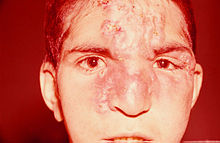Nonvenereal endemic syphilis
| Nonvenereal endemic syphilis | |
|---|---|
| Specialty | Infectious disease |
Bejel, or endemic syphilis, is a chronic skin and tissue disease caused by infection by the endemicum subspecies of the spirochete Treponema pallidum.
Bejel is also known by a variety of other names, including belesh, dichuchwa, endemic syphilis, nonvenereal syphilis, frenga, njovera, skerljevo, siti, or treponematosis-bejel type.[1][citation needed]
Causes
Although the organism that causes bejel, Treponema pallidum endemicum,[2] is morphologically and serologically indistinguishable from Treponema pallidum pallidum, which causes venereal syphilis, transmission of bejel is not venereal in nature,[3] generally resulting from mouth-to-mouth contact or sharing of domestic utensils, and the courses of the two diseases are somewhat different.
Presentation

Bejel usually begins in childhood as a small mucous patch, often on the interior of the mouth, followed by the appearance of raised, eroding lesions on the limbs and trunk. Periostitis (inflammation) of the leg bones is commonly seen, and gummas of the nose and soft palate develop in later stages.
Epidemiology
Bejel is mainly found in arid countries of the eastern Mediterranean region and in West Africa, where it is known as sahel. (Sahel disease, which should be distinguished from "Sahel", the geographical band between the Northern Sahara and Southern Sudan.)
Treatment
It is treatable with penicillin or other antibiotics, resulting in a complete recovery.
See also
References
- ^ Medical Microbiology 6th edition, by Patrick R. Murray, Ken S. Rosenthal, Michael A. Pfaller
- ^ Antal GM, Lukehart SA, Meheus AZ (January 2002). "The endemic treponematoses". Microbes Infect. 4 (1): 83–94. doi:10.1016/S1286-4579(01)01513-1. PMID 11825779.
- ^ Pace JL, Csonka GW (October 1984). "Endemic non-venereal syphilis (bejel) in Saudi Arabia". Br J Vener Dis. 60 (5): 293–7. doi:10.1136/sti.60.5.293. PMC 1046341. PMID 6487985.
